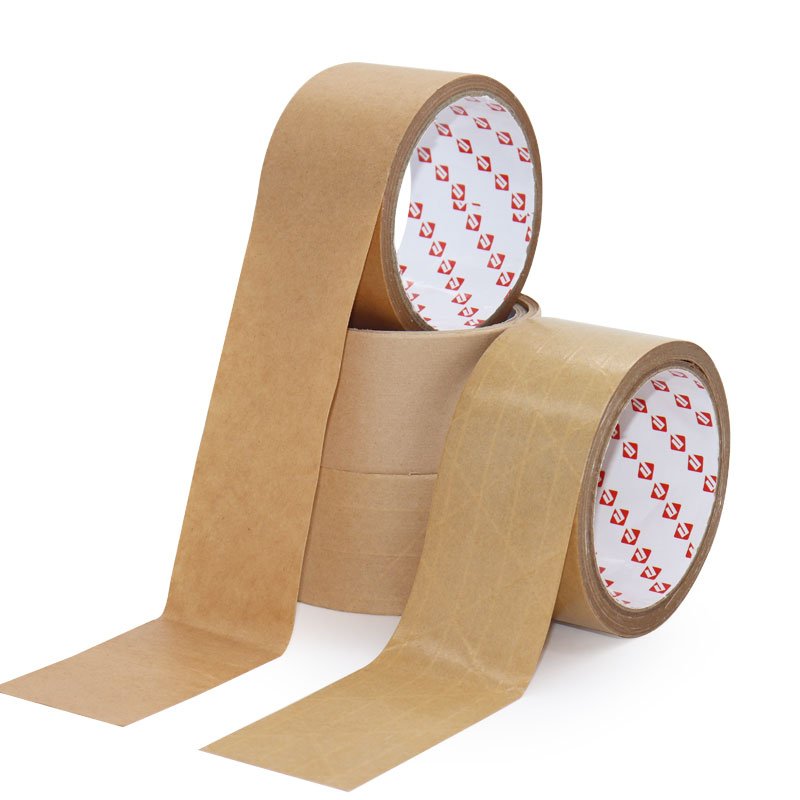Kraft Paper Tape comes with different grades while the adhesion value and thickness of the paper have to be adjusted according to application. Kraft Paper Tape is widely used for color separation and painting made by hand or by spray, furniture making, automobile, and aircraft painting, appliance manufacturing, decorative glass making, powder coating, plating, and sandblasting.
The need for inexpensive Kraft Paper Tape became apparent when the automotive industry needed to mask off certain areas of their cars during the painting process. This prompted the development of masking tape and other saturated (impregnated) Kraft Paper Tapes. The two main types of saturated paper backings are crepe paper and flatback paper. The paper color can vary from white (bleached) to light tan (semibleached), and dark tan (unbleached). If a darker raw paper is used and a lighter shade of tape is desired, some TiO2 may be incorporated into the adhesive and/or saturant formula.
Saturants include natural rubber, styrene-butadiene rubber, and various water-based latexes. The first release coatings for saturated Kraft Paper Tapes were natural and synthetic polymers such as shellac, starch, casein, and nitrocellulose. Saturated papers, coated with pressure-sensitive adhesives, sometimes show a lowering of tack and adhesion on aging. In most cases, this effect is due to the tackifier resin migrating from the adhesive into the saturant. Unsaturated kraft Kraft Paper Tapes have been developed most recently.
The adhesive is usually a natural rubber type, but hot melt adhesives are also used. Silicone-based release coatings are used on the reverse of the paper carrier to keep the layers of tape from attaching to each other in the roll and to counter the tendency for delamination of the adhesive and kraft paper backing. This useful piece of information was provided by AIC Wiki.
Masking tapes date back to 1925. Masking tape was invented by Richard Drew after witnessing the frustration of auto bodyworkers as they used butcher paper to cover the cars they were painting. The ineffectiveness of butcher paper in auto-body applications made Drew search for better alternatives.
Kraft Kraft Paper Tape has a natural rubber based adhesive system that makes an excellent bond to most packing products and surfaces. Its tough backing remains strong under moist conditions and outdoor weathering is good. It is an approved packing tape by the U.S. Postal Service and UPS. Its typical applications include carton sealing, packing, splicing, freezer tape, and straight-line masking. It is also used in silk screening and picture framing.
Paper tapes come with different grades while the adhesion value and thickness of the paper have to be adjusted according to application. Widely used for color separation and painting made by hand or by spray, furniture making, automobile, and aircraft painting, in appliance manufacturing, decorative glass making, powder coating, plating, and sandblasting.
The benefits of using Kraft Paper Tape today:
Biodegradable and recyclable: One of the most significant advantages of paper tape is its biodegradability. When discarded or exposed to the elements, paper tape breaks down naturally over time, contributing to a reduction in long-lasting waste. Unlike plastic tape, which persists in the environment, paper tape leaves behind minimal traces, alleviating the burden of plastic pollution. Paper tape can also be easily recycled alongside cardboard boxes, simplifying the recycling process and promoting a circular economy approach to packaging materials.
Renewable materials: Paper tape is predominantly made from sustainable sources, such as Kraft paper, which is derived from wood pulp obtained from responsibly managed forests. Unlike plastic tape, which relies on fossil fuels, the production of paper tape helps reduce dependence on finite resources. By supporting the use of renewable materials, companies and individuals contribute to conserving natural habitats and promoting responsible forestry practices.
Safe for the environment and humans: Paper tape is usually free from harmful chemicals, making it a safe and eco-friendly option for packaging various products. Unlike some plastic adhesives that may contain harmful additives, natural rubber adhesive used in paper tape is less likely to pose health risks to both users and the environment.
Versatile applications: Paper tape can be used for a wide range of packaging needs, from sealing lightweight parcels to securing heavy-duty cartons. Its strength and adhesive properties can effectively hold together various packaging materials, making it suitable for diverse industries and products.
Aesthetic appeal: Beyond its eco-friendly attributes, paper tape can enhance the visual appeal of packages. Some companies choose to print their logos or branding on paper tape, creating a professional and eco-conscious image that resonates with customers who prioritise sustainability.



